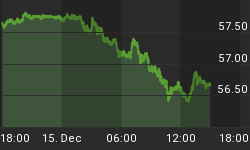Just when you think it can't get any stranger, the U.S. economy - measured by the declining number of full-time jobs, lower household incomes and below target inflation rate - seems to be weakening, while the most speculative asset markets lurch back into full-tilt bubble mode. Home prices in Vegas, Silicon Valley, and Miami are above 2007 levels, equities are near all-time highs, and bank stocks are once again dominant in the S&P 500. It's as if 2008/2009 never happened. And now this from Bloomberg, about the return of junk bonds:
Bond Hubris Overwhelms Fed in Riskiest Credit-Market Sectors
Bond investors trying to divine when the Federal Reserve will reduce its unprecedented monetary stimulus are increasingly looking to the riskiest parts of the debt market, which are booming like before the financial crisis.
The amount of loans made this year that lack standard protections for lenders exceed the all-time high set in 2007, and only one other time have investors pumped more money into funds that buy lower-rated loans than they did last week. Bonds rated in the lowest category of junk accounted for the greatest percentage of speculative-grade offerings last month since 2011.
Funds that purchase speculative-grade, or leveraged, loans in the U.S. attracted $2 billion last week, the second-biggest inflow on record, according to Charlotte, North Carolina-based Bank of America Corp. Companies will raise as much as $360 billion of the debt this year, Barclays Plc said Aug. 9, up from an earlier estimate of as much as $250 billion.
Lacking Safeguards
The market for so-called covenant-light loans that lack typical lender safeguards such as limits on debt has already soared to $155 billion this year, beating the record $96.6 billion in 2007, according to Standard & Poor's Capital IQ Leveraged Commentary and Data.
Junk-bond sales rose 24 percent to $235.3 billion through Aug. 9 compared to the same period a year ago, according to data compiled by Bloomberg. Those securities and leveraged loans are rated below Baa3 by Moody's Investors Service and less than BBB-at S&P.
Sales of payment-in-kind, or PIK, notes, which allow borrowers who can't meet interest obligations to pay with additional debt, total more than $6.5 billion this year, on pace to top the $8.1 billion issued in 2012, Bloomberg data show.
Corporate bonds in the lowest rating tier of CCC made up 10.3 percent of the $22.4 billion in high yield sales in July, the most since 2011, according to JPMorgan Chase & Co.
Corporate default rates, at about 3 percent, are near historic lows, according to Moody's, generating a sense of complacency among investors.
'Pattern' Detected
Fed Governor Stein said in a February speech that investors in company debt had been engaging in "a fairly significant pattern of reaching-for-yield behavior."
At 7.4 percent, the jobless rate remains above the Fed's 6.5 percent target, while the rate of inflation is below 2.5 percent, levels policy makers said would trigger a reduction in its bond purchases.
Speculating 'Serpent'
Investors convinced the Fed is going to keep interest rates low through 2016 are more willing to take risk and add leverage, forcing the central bank into a balancing act to encourage lending while preventing bubbles, according to Lawrence McDonald, senior director for credit, sales and trading at Newedge USA LLC.
"If you're too accommodative, the serpent in the market will come back and start speculating really quickly, and that's what's happened to some extent," he said in an Aug. 5 telephone interview. "They're watching that like a hawk."
Some thoughts
Let's start with some of the more amusing quotes from the above article:
"Corporate default rates, at about 3 percent, are near historic lows, according to Moody's, generating a sense of complacency among investors." By now we should have learned that default rates are always low at the peak of a bubble because when money is freely available, almost no one has to default. But as soon as the cash tide goes out, to use Warren Buffett's turn of phrase, you quickly find out who's been swimming naked. So a low default rate in a speculative sector points to a high default rate a year or two hence.
"Fed Governor Stein said in a February speech that investors in company debt had been engaging in 'a fairly significant pattern of reaching-for-yield behavior.'" Which is exactly what Governor Stein's organization has been trying to engineer. By forcing interest rates down, the Fed hopes to cause everyone from retirees on fixed incomes, to young families saving for their kids' college, to municipal pension funds, to move way out on the risk curve, speculating in stocks, junk bonds and derivatives. To the extent that it's working, it is doing so by sacrificing a whole generation of unsophisticated investors who are in completely inappropriate investments and will be crushed when those markets turn down.
"If you're too accommodative, the serpent in the market will come back and start speculating really quickly, and that's what's happened to some extent ...They're watching that like a hawk." Yes they're watching, and they're relieved to see speculation finally breaking out in the junkiest sectors of the economy. The Hail-Mary strategy is to get the animal spirits going and hope it translates into sustainable growth - despite the fact that the junk bond bubble of the 1980s, the tech bubble of the 1990s, and the housing bubble of the '00s all failed to do so.
Anyhow, that speculative markets are looking like 2007 while the velocity of money is at record lows is truly fascinating, and raises the question of how those markets will behave if normal velocity returns. But it's okay, the experts are watching it like a hawk.
















